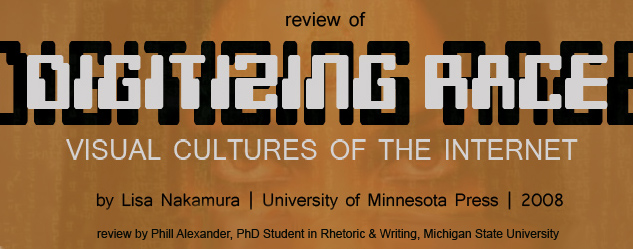

Introduction:
Digital Racial Formations
Chapter 1:
"Ramadan is Almoast Here"
Chapter 2:
Alllooksame
Chapter 3:
The Social Optics of Race
Chapter 4:
Avatars and Visual Culture
Chapter 5:
Measuring Race on the Internet
Epilogue:
Racio-Visual Logic
Conclusions on Digitizing Race
Lisa Nakamura's Digitizing Race: Visual Cultures of the Internet, much like her Cybertypes (2002) addresses the often discussed by rarely written about—and hardly ever theorized and grounded—concept of digital identity. All the more critical in the study of digital media, Nakamura places the focus on issues of race. Unlike Cybertypes, however, in this newer work Nakamura appears to be working in a specific subfield. It is important to recognize from the outset of reading Digitizing Race that Nakamura is applying a specific lens in her readings, one that might be less familiar to those in the fields of rhetoric and composition or professional writing. She defines her positionality as that of a "visual cultural studies” scholar: My mode of critique in this book is to employ the paradigm of visual cultural studies to focus on the ways that users of the Internet collaboratively produce digital images of the body – very particular things for very particular uses—in the context of gender identity formation. (p. 5)Nakamura defines visual cultural studies as "less interested in communication, per se than other fields,” and as "an interdisciplinary type of theoretical and critical practice with practitioners from all sorts of backgrounds who share a focus on the production of identity in visual forms” (p. 5). Visual cultural studies, as Nakamura explains in the introduction, works to avoid being defined as a single discipline (a goal some readers will no doubt find problematic, as academic disciplines tend to cohere based on being named by a body that shares in a specific sort of work and hence become "disciplined"). I stress this because I believe it is important for potential readers to know that my disciplinarity as a digital and visual rhetoric student may at times manifest itself in disagreement with Nakamura’s goals due to the ways in which I have read and would seek to utilize the text. The links to the left provide access to discussion of individual chapters and sections of the book as well as some reflection on how the text might be used by visual rhetoric scholars. On the whole, the book serves to fill a considerable gap in current digital media studies, looking at race in terms of how users identify themselves in various online situations from instant messaging to message forum avatars, how websites depict race, how film depicts uses of technology in racialized ways, and offers valuable tools for consideration of race online in a particularly well written conclusion and epilogue. |